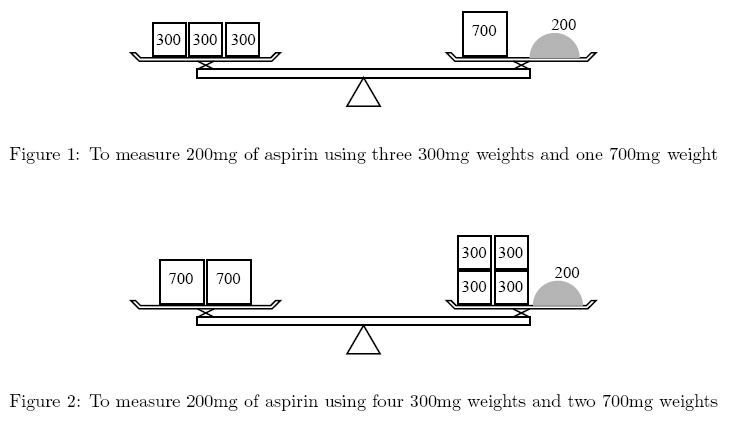POJ 2142 The Balance(扩展欧几里德解方程)
The Balance
| Time Limit: 5000MS | Memory Limit: 65536K | |
| Total Submissions: 2490 | Accepted: 1091 |
Description
Ms. Iyo Kiffa-Australis has a balance and only two kinds of weights to measure a dose of medicine. For example, to measure 200mg of aspirin using 300mg weights and 700mg weights, she can put one 700mg weight on the side of the medicine and three 300mg weights on the opposite side (Figure 1). Although she could put four 300mg weights on the medicine side and two 700mg weights on the other (Figure 2), she would not choose this solution because it is less convenient to use more weights.
You are asked to help her by calculating how many weights are required.

You are asked to help her by calculating how many weights are required.

Input
The input is a sequence of datasets. A dataset is a line containing three positive integers a, b, and d separated by a space. The following relations hold: a != b, a <= 10000, b <= 10000, and d <= 50000. You may assume that it is possible to measure d mg using a combination of a mg and b mg weights. In other words, you need not consider "no solution" cases.
The end of the input is indicated by a line containing three zeros separated by a space. It is not a dataset.
The end of the input is indicated by a line containing three zeros separated by a space. It is not a dataset.
Output
The output should be composed of lines, each corresponding to an input dataset (a, b, d). An output line should contain two nonnegative integers x and y separated by a space. They should satisfy the following three conditions.
No extra characters (e.g. extra spaces) should appear in the output.
- You can measure dmg using x many amg weights and y many bmg weights.
- The total number of weights (x + y) is the smallest among those pairs of nonnegative integers satisfying the previous condition.
- The total mass of weights (ax + by) is the smallest among those pairs of nonnegative integers satisfying the previous two conditions.
No extra characters (e.g. extra spaces) should appear in the output.
Sample Input
700 300 200 500 200 300 500 200 500 275 110 330 275 110 385 648 375 4002 3 1 10000 0 0 0
Sample Output
1 3 1 1 1 0 0 3 1 1 49 74 3333 1
Source
代码:
#include<stdio.h> #include<math.h> #include<iostream> #include<algorithm> using namespace std; int extend_gcd(int a,int b,int &x,int &y) { int m,tmp; if(b==0&&a==0) return -1; if(b==0) { x=1; y=0; return a; } m=extend_gcd(b,a%b,x,y); tmp=x; x=y; y=tmp-(a/b)*y; return m; } int main() { int a,b,d; int x,y; int X,Y; int X1,Y1; while(scanf("%d%d%d",&a,&b,&d)) { if(a==0&&b==0&&d==0) break; int flag=0; if(a<b) { flag=1; int t=a; a=b; b=t; } int gcd=extend_gcd(a,b,x,y); x*=d/gcd; y*=d/gcd; int tmp=a/gcd;//Y=y-tmp*t; double t=(double)y/tmp; int t1=(int)floor(t); X=x+(b/gcd)*t1; Y=y-tmp*t1; if(t1!=t)//t是小数 { t1=t1+1; X1=x+(b/gcd)*t1; Y1=y-tmp*t1; if(abs(X1)+abs(Y1)<abs(X)+abs(Y)) { X=X1; Y=Y1; } else if(abs(X1)+abs(Y1)==abs(X)+abs(Y) && a*abs(X1)+b*abs(Y1)<a*abs(X)+b*abs(Y)) { X=X1; Y=Y1; } } if(flag==0) printf("%d %d\n",abs(X),abs(Y)); else printf("%d %d\n",abs(Y),abs(X)); } return 0; }
人一我百!人十我万!永不放弃~~~怀着自信的心,去追逐梦想


